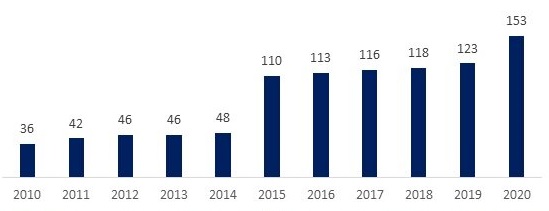Iranian Scientific Journals Growth in Clarivate Analytics
One of the policies of the Iran higher education system is journals’ internationalization, which is in line with their mission, and ultimately, publishing scientific findings for researchers. The number of international publications is one of the indicators emphasized in any country’s scientific map, and the promotion of Persian language, as an international scientific language.
The number of publications in ISI database (Clarivate Analytics) is constantly changing and after evaluation, if the needed points earned, they will be indexed in this database and on the other side, a group of publications are removed from this list annually. The present journals are cited in 4 indexes of sciences, social sciences, arts and humanities. These publications evaluations is not specific to Iran and is common throughout the world. The number of publications in these 4 indexes is 21335, of which 13607 publications are related to the three indexes of science, social sciences, art and humanities and 7728 of them belong to the Emerging Sources Citation Index. At present, in 2020, the number of Iranian publications in the four main ISI indexes is 153. These four indexes structured the basis WoS citation database, but the number of publications will change by the end of 2020.
The number of Iranian publications indexed in ISI database (Clarivate Analytics) in 2019 was 123, which is almost three times more than 2010. In 2010, the number of Iranian publications in ISI was 36, which in 2011 increased to 42. In 2012, the number of publications increased again to 46. From 2013 to 2018, the number of Iranian publications in ISI reached 46, 48, 110, 113, 116 and 118, respectively.
After a decade, the main challenge of the country's publications is still the use of science that they produce. Journal citation reports (JCR), only indexed publications that have an impact factor. The impact factor follows the formula that is required to obtain a citation. Publications whose articles receive a citation impact factor in the two years leading up to the year will have an impact factor, and citations indicate the use of journal citations.
Iran's impact factor publications in JCR show that despite the increase in the number of Iranian publications, they do not have an impact factor. Therefore, one of the major challenges for publications after being indexed in ISI citation database is to obtain citations according to the formula on which the impact factor is calculated.
It should be noted that one of the reasons for the significant increase in the number of Iranian indexed journals in 2015 was the addition of the index of emerging journals in this international citation database. One of the main challenges of the country's publications is the use of their content among international researchers, which can be examined by reviewing citations to journals. Improving the quality of content, internationalization of the journal, as well as the visibility of the journal's articles are factors that can help increase the number of citations to the journal.
Indexing journals in international indexes is very important from the point of view of science policy makers. Although the share of Persian language as well as the number of indexed publications in international citation indexes has increased in recent years, a comparison of the number of internationally indexed journals with what is not indexed shows. Most of these publications are indexed and published only in national databases.
Iran is ranked 22nd in the world and 2nd in the Islamic world in terms of the number of scientific publications indexed on the ISI database. Turkey indexes 225 publications in the database among Islamic countries, which ranks it 15th in the world. The United States, the United Kingdom, the Netherlands, Germany, and Switzerland are the five countries that have indexed the world's most scientific journals in the ISI citation database, meaning that the world's largest scientific publishers are located in these countries. Spain, Brazil, Italy, Poland and India are the next countries to be more active in publishing top scientific journals.
Indexing journals in international databases, especially citation databases, increases the likelihood of visiting the journal and its content, which makes more researchers familiar with the journal and seek to publish the article in that journal. As a result, the likelihood of citing a journal using more of its content will increase.
Iranian Journals in ISI

